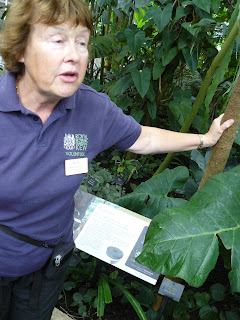I was at the Kew Gardens yesterday with former colleagues from Cambridge.
Kew Gardens is where we got our first rubber seeds from the British. So whenever I hear of or see Kew Gardens in the map, I would always associate this place with our rubber.
As a kid, I absorbed facts without questioning regardless whether they were right or wrong, but there was an occasion when I asked the teacher if Kew Gardens belonged to Lee Kuan Yew!
You know I'm really not a bright person since young. Who would have made up Kuan+Yew=Kew??!!
Anyway, if you're laughing now, imagine 38 others doing the same to me in class. It was more traumatic as a kid then. You can imagine why do I still remember this after 20 years! Haha!
Anyway, when I was at the Gardens yesterday, my mind was set on two things - the treetop walk and the Palm House. I learnt that the Palm House is the tropical climate glasshouse which would feature among which, the rubber tree.
When we reached the rubber tree, the guide from the walking tour explained that "Kew does not have a very proud history of the rubber tree". It grabbed my attention.
Mary, our guide told us that the British came across the rubber tree in Brazil. They saw the potential use of rubber and smuggled some seeds out of the country.
When I checked in Google awhile ago, "some" was obviously an understatement to the real figure of 70,000 seeds!
The seeds reached Kew Gardens after many attempts as rubber seeds die easily. Furthermore, it takes ages to get from one place to another in those days (there were no planes then!) and by the time the seeds arrived Kew, they would have withered.
But you can't go too wrong with 70,000 seeds! I am sure at least a few thousands survived.
The survivor seeds were cultivated in Britain and then dispatched to two British colonies. First it went to Sri Lanka. Then it went to Malaya, as we were known then.
Even though the seeds went to two countries, it was in Malaya that rubber grew up to commercial scale. As it is now, rubber is one of our biggest commodities in the country.
I was still thinking why weren't we told of this other side of our rubber history and how it came to Malaysia. To prove my point that we weren't told the story, I tried Wikipedia in the Malay language version and I was right that there was no mention of the "theft"!
I tried to reason out that's probably because it's not an important historical fact. Stolen or not, rubber is one of Malaysia's commodities and no one can take that away now anyhow.
Furthermore, our history books were probably altered by the British before we got our independence and that would have gone under the scissors.
Unless someone can tell me that they know about the theft, I can safely assume that most, if not all Malaysians would still know about the truncated version of the history of rubber. But if I'm the only one who was not paying attention in class some 20 years ago, or the teacher didn't tell us that, then I'll hunt my primary school teacher down to apologise.
But I am lucky to learn about this somehow and ironically, in Kew Gardens. Not too late to know but it was a long way to find out that our rubber history is skewed!



2 comments:
don't go lah
Thanks for dropping by my blog. I've read several posts of yours, really interesting.
Post a Comment